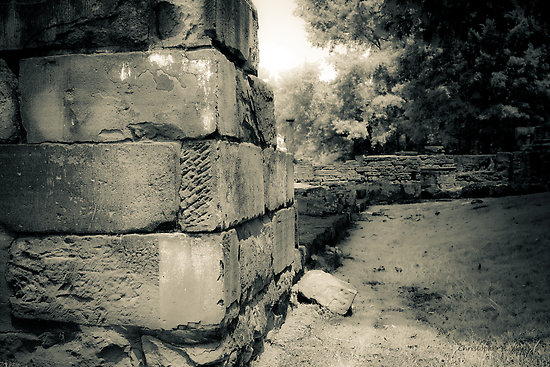Who is The Man of Sin?
The apostle Paul told the Thessalonians that the destruction of Jerusalem would not come until the rebellion had occurred and the leader of the rebellion, the “man of lawlessness,” was revealed. He then told them what types of things this rebel leader would do.
He will oppose and will exalt himself over everything that is called God or is worshiped, so that he sets himself up in God’s temple, proclaiming himself to be God (2 Thessalonians 2:4).
Remember that this is a letter written to an actual church who needed to heed his warnings as at that time. The case for audience relevance cannot be overemphasized here.
The scripture above is a clear indicator of who could and could not be the “man of sin.
Whoever this person is, he would have to be a person who would have physically been able to stand in the Temple and proclaim himself God.
This would require a person to be alive before AD 70, when the temple was destroyed, because at no time since AD 70 has there been a Temple for the man of sin to stand in. There are those who have been proclaiming a rebuilt temple. It is quite unfortunate that there is no New Testament verse that predicts a rebuilt Jewish Temple.
It is necessary for a temple had to be standing for the man of lawlessness to stand in it. This helps us understand the timeframe.
One thing is certain, which is that this man would cause the destruction of the temple. Based on historical records, one man fits the bill. The main rebel who caused the destruction of Jerusalem was John Levi of Gischala.
Josephus The Jewish historian wrote of how John Levi was a selfish, unscrupulous man with persuasive powers who convinced many that he was sent by God to liberate them. Further, John Levi took over the Temple, set himself up in the Temple as the Jewish savior (as God), looted the vessels of the Temple for their gold, and caused the daily animal sacrifices to cease. He also plundered the people, even burning their storehouses of food and causing the great famine that starved tens of thousands to death, and he enlisted aid from the Idumeans, who killed 8,500 of the Jews, including the priests.
2 Thessalonians 2:9 speaks of counterfeit signs being performed by this man. It would interest you to know that John Levi declared that he was God and would deliver the people from the Romans. He commanded the storehouses of food to be burned in faith that He would miraculously deliver them from their enemies. Instead they starved to death because nothing spectacular happened.
Even when the Roman General Titus pleaded that John Levi leave the Temple, so that it wouldn’t be destroyed in battle, John completely refused. If not for this stubborn position the Temple might have been spared, as the Romans considered it as one of the wonders of the ancient world.
Paul goes on to explain more about the man of lawlessness:
Don’t you remember that when I was with you I used to tell you these things? And now you know what is holding him back, so that he may be revealed at the proper time. For the secret power of lawlessness is already at work; but the one who now holds it back will continue to do so till he is taken out of the way (2 Thessalonians 2:5-7).
John was not only a rebel leader, but also a false messiah. He claimed godhood by taking over the temple, and the only person who stood in his way was the Jewish Chief Priest, Ananus. Ananus was known for his great diplomatic skills as he had been able to negotiate peace treaties with Rome many times before.
Ananus the high priest was literally able to restrain the full-scale rebellion that John Levi was aiming to accomplish. That is why Paul referred to the one who restrained, who must be taken out of the way.
Even Josephus noted that once Ananus the high priest (the one who restrains) was killed, then the destruction of Jerusalem began. The death of Ananus was the beginning of the destruction of the city and the ruin of her affairs.
And then the lawless one will be revealed, whom the Lord Jesus will overthrow with the breath of his mouth and destroy by the splendor of his coming (2 Thessalonians 2:8).
When the “coming of the Lord” occurred with the destruction of Jerusalem, John Levi was finally dealt with. He was the cause of the rebellion, which led to the attack by the Romans. He also set up his militia in the Temple, murdered all the priests, and caused not only all of Jerusalem to be destroyed, but even the temple, which the Romans didn’t want to harm.
History proves the writers of the new testament texts to be true. From the prophecy of Jesus to all the apostles wrote about, there seems to be a very consistent narrative that played out in the judgment upon the old city that symbolized a world that was made obsolete by the cross.
It would be error of mighty proportions to take that same texts apply them to our timelines to justify doctrines that herald a rapture and revelation of an antichrist.
There are many teachings that suggests that the man of sin or lawlessness is the antichrist that would be revealed in our current dispensation. From comprehensive studies on prophetic texts, they fail to reach wholesome conclusions but what can only serve to justify a narrow perspective that seeks to bring the world to an end.
To understand the term antichrist as we used by John, we must first understand the context of his writings. During the time of the first century Church, there was a cult system called Gnosticism. They taught that the spirit was good and the physical/emotional realms were evil, therefore Jesus could not have come to earth in an actual physical body. They taught that Jesus came to earth only as an ethereal spirit being. This teaching negates the truth of Jesus shedding His human blood for the remission of sin. The Gnostics gained so many followers in the early Church (about a third of the first century Church) that John wrote his first epistle in response to their heresy.
That which was from the beginning, which we have heard, which we have seen with our eyes, which we have looked at and our hands have touched—this we proclaim concerning the Word of life. The life appeared; we have seen it and testify to it, and we proclaim to you the eternal life, which was with the Father and has appeared to us. We proclaim to you what we have seen and heard, so that you also may have fellowship with us. And our fellowship is with the Father and with his Son, Jesus Christ (1 John 1:1-3).
John was writing to prove, as an eyewitness, that Jesus was not a ghost, but a real physical person. John was the disciple who leaned his head upon Jesus’ chest, and he knew that Jesus was not merely a spirit. He even remarked in John 1:14, “The Word became flesh and made his dwelling among us. We have seen his glory, the glory of the one and only Son, who came from the Father, full of grace and truth.”
The apostle’s writings were targeted to those who had fallen into the first century Gnostic doctrine. John explained further in his epistle, to say that those who claimed Jesus didn’t have a physical body were actually antichrist.
Dear friends, do not believe every spirit, but test the spirits to see whether they are from God, because many false prophets have gone out into the world. This is how you can recognize the Spirit of God: Every spirit that acknowledges that Jesus Christ has come in the flesh is from God, but every spirit that does not acknowledge Jesus is not from God. This is the spirit of the antichrist, which you have heard is coming and even now is already in the world (1 John 4:1-3).
Many deceivers, who do not acknowledge Jesus Christ as coming in the flesh, have gone out into the world. Any such person is the deceiver and the antichrist (2 John 1:7).
Any person who denies that Jesus came in the flesh, which is what the Gnostics of the first century were doing, is operating in the spirit of antichrist. The antichrist isn’t a person; it is a belief system, specifically, Gnosticism.
John further mentions the antichrist spirit as something that the early believers had already heard of:
Dear children, this is the last hour; and as you have heard that antichrist is coming… (1 John 2:18 NASB).
First, it is important to note that certain Bible translations have inserted a word that is not in the Greek manuscripts; this has led to much confusion we see today. These translations capitalize the word antichrist in First John 2:18.
The reason for the capitalization is because the translators inserted the word the before the word antichrist, thus making antichrist into a proper noun, which requires capitalization.
The early Church had heard that antichrist (false teaching) was coming, but they had not heard that the Antichrist (a one-world ruler) was coming. The insertion of the and the capitalization of Antichrist was added 1500 years later by the translators.
So many teachings link this together and expect the so-called Antichrist to be revealed as the man of sin/lawlessness which coincide with the time of the rapture or physical return of Jesus to pick up the church.
None of these falls into the true narrative of the prophetic view of the early apostles who were expecting some events to happen in their time and among their contemporaries. Hence the need to write and admonish them to be prepared as the events playing out in their time was to herald a soon-coming judgement upon that old covenant world that was ready to pass away.
Now we live in the age of the increasing kingdom which will brighter and brighter in splendor and glory. This is where we are no matter what happens in our world today. Jesus has the victory and it will resound throughout the earth eventually.



There will soon be a new Temple in Jerusalem beside satan’s ABYSS [rev11-7] Synagogue [Ezekiel 8] under the Dome of the Rock that was built by the anti Christ who magnified himself ‘equal to the commander of the Host who is Jesus ‘king of the Jews’-Matthew 27;37. anti Christ is the 11th king/horn[most popular; opposite Jesus -8th head [3 repeat twice & 7th- Rabin- fatally wounded] known as the ‘little horn[son] =BIBI-hebrew- Binyamin Netanyahu =666 old Hebrew Gematria who is currently trying to pass into Law compulsory marking ALL the children of Israel with his Teva Biotec RfId right hand micro chipping System ……Maranatha Shalom…..he fulfills ALL prophecy….old MessianicJew.
None of what you have submitted lines up with the timelines of prophecy and the audience. You can’t piece together isolated verses and form a doctrine out of it, otherwise same would have been written in the year 1745 and been long as false. The testimony of the scriptures has to see alingment and consistency from the first century, 1205, 1480, 1945 and even in 2020.
this is quite expository. One may not have full grasp of biblical truths without recourse to historical events which when pieced up together provides answers to some controversial areas of biblical prophesies which many have ignorantly build false doctrines around.
‘come as a child’ Jesus said. The man of sin wants to be who Jesus is-Matt27;37- Jesus king of the Jews & be what Jesus is- ‘the right hand son’ -hebrew; Binyamin & ‘God’s Gift- hebrew; Netanyahu[not his real name but changed to magnify] .God spells it out if you have insight. Now having had it spelt out you should see if he fulfills ALL other Prophecy . I promise you he does! he will be revealed at End Time- Now- we are in Great Tribulation! When he came to power WAS 1996 -5 were gone[dead], one is to come & did as Pres.Perez many years, one a short time to go-Shamir d.2014 & he was like a leopard- born in Arabic Palestine; feet like bear-parents from USSR; speaks like lion -bellows in Hebrew & English. WAS NOT 1999 subdued 3 kings Dan11…1. prepared to give the daughter of women as combined capitol with Palestinians-removed. 2. goes to the coastland & falls-Sharon-with stroke in 3days -removed . 3. the collector of taxes- Olmert previously Treasurer -removed. I do not cobble together facts I have simply been given insight by HE that visits me…..I asked Why me? as I have never been a religious man. HIS answer- ‘you do not understand who you are descended from’….’I had seven horns [sons- Rev 5;6 .the man of sin has two horns-sons] who were mortal & they are my seven eyes in spirit.’ ‘you are my seed -[offspring- Isaiah 53;10] ‘- as are many. Well you can believe it or not but he sent me to an old Rabbi one Sabbath years ago. The nursing staff asked me to stay as he had nobody. I told them he was going home today . They shook their heads in disbelief as he was riddled with bone cancer about to die- under 50 kilos -a big man once. He gasped ‘who sent you’….’Our Lord but I am not Alone’ .He tried to see the Holy Spirit but could not ,so I took his hands & he certainly felt it as did I . ‘Stanley Ben- Moshe take yourself up & go home you are not dying today’ His eyes bugged & he gently shook while my hands so ached & the hairs all over stood up. ‘I am coming to see you preach’ Christ risen’ in 5 weeks & you have a new Christian Ministry in 6 mnths for Yeshu.’…..He went home & ALL I was bid to tell him was fulfilled……HE has given me authority I believe to reveal ALL that has been hidden -except ofcourse the month ,day & Hour!……Netanyahu has had his[Dan7;25] ‘they[Israel] will be given into his hand a Time[3.5yrs-Biblical hour]Times[X3.5yrs] & a half a Time[+1.75yrs] = 14yrs WAS 1996 WAS NOT 1999 WAS AGAIN 2009 until election failure April 2019-caretaker king -until coalition with B.GantzMay2020 until election failure 2021[14yrs] -caretaker king until [Dan 7;26]’ court will be called into Judgement’ & he will be permanently removed[Rev 10;1 the fallen star who is satan]-the New True Temple will soon after be rebuilt & the Last Two Prophets will come measuring I believe so Watch Wait & See! ….Baruch Hashem in Yeshu ha Moshiach ….HE Lives…HE speaks …servant listens… Maranatha Shalom…old Messianic Jew.
this is quite expository. One may not have full grasp of biblical truths without recourse to historical events which when pieced up together provides answers to some controversial areas of biblical prophesies which many have ignorantly build false doctrines around.